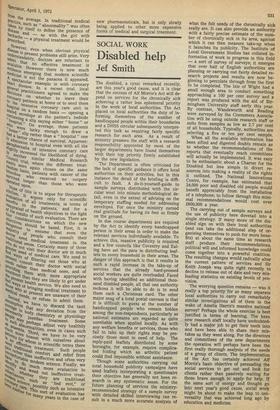SOCIAL WORK
Disabled help
Jef Smith
The disabled, a cynic remarked recently, are this year's good cause, and it is clear that the success of Alf Morris's Act will de pend on services for the chronically sick achieving a rather less ephemeral priority in the work of local authorities. The Act placed on local authorities the duty of in forming themselves of the number of handicapped people within their boundaries and a DHSS circular subsequently interpre. ted this task as requiring fairly specific research for each area. As a result of ministry pressure the staff with a research responsibility appointed by most of the larger departments have found themselves with their top priority firmly established by the new legislation.
The Department is often criticised for the lack of specific guidance it offers local authorities on their activities, but in this instance the detail of the briefing is difficult to fault. A do-it-yourself-guide to sample surveys distributed with the circular went into minute methodological detail, even to the extent of advising on the temporary staffing needed for addressing envelopes. For once the ministry earned real gratitude for having its feet so firmly on the ground.
In due course departments are required by the Act to identify every handicapped person in their areas in order to make the relevant services individually available. To achieve this, massive publicity is required and a few councils like Coventry and Ealing have set the pace in distributing leaflets to every household in their areas. The danger of this approach is that it results in such a rapid increase in the take-up of services that the already hard-pressed social workers are quite overloaded. Faced with having identified an additional thousand disabled people, all that one authority reckons it will be able to do is to send them each a Christmas card. The other major snag of a total postal canvass is that it is difficult to guess at the number of handicapped people who remain hidden among the non-respondents, particularly as national estimates are regarded as quite unreliable when applied locally. As with any welfare benefits or services, those who fall to take up their rights may be precisely those most in need of help. The reply-paid leaflets distributed by some boroughs, for example, require complicated folding which an arthritic patient could find impossible without assistance.
Though some authorities carrying out total household publicity campaigns have used leaflets incorporating a questionaire their objective has generally not been research in any systematic sense. For the future planning of services the ministryrecommended strategy of a sample survey with detailed skilled interviewing can result in a much more accurate analysis of what the felt needs of the chronically sick really are. It can also provide an authority with a fairly precise estimate of the number of chornically sick in its area, against which it can then measure take-up when it launches its publicity. The Institute of Local Government Studies has collated information of work in progress in this field — a sort of survey of surveys; it emerges that over half of English authorities are planning or carrying out fairly detailed research projects and results are now beginning to percolate through from the first to be completed. The Isle of Wight had a small enough area to conduct something approaching a 100 per cent survey and a report was produced with the aid of Birmingham University staff early this year. By contrast, Wandsworth and Reading were surveyed by the Consumers Association will be using outside research staff or sults from samples as low as 2.7 per cent of all households. Typically, authorities are selecting a five or ten per cent sample. When all the available information has been sifted and digested doubts remain as to whether the recommendations of the reports that eventually reach committees will actually be implemented. It was easy to be enthusiastic about a Charter for the Disabled but less simple to divert resources into making a reality of the rights it outlined. The National Innovations Centre, for example, has estimated that 24,000 poor and disabled old people would benefit appreciably from the installation of a telephone; to follow through this minimal recommendations would cost over £600,000 a year.
The carrying out of sample surveys and the use of publicity here dovetail into a single strategy. If many more of the disabled sign on with their local authorities (and can take the additional step of organising themselves to push for more benefits) at about the same time as research staff produce their recommendations, political will and informed knowledge could come together into a powerful coalition. The resulting changes would radically alter the current pattern of services and Sir Keith Joseph was quite right recently to decline to release out of date and very misleading statistics on existing levels of provision.
The worrying question remains — was it really a top priority for so many separate local authorities to carry out remarkably similar investigations all of them in the wake of Amelia Harris's massive national survey? Perhaps the whole exercise is best justified in terms of learning. The keen new research staff locally have undoubtedly had a major job to get their teeth into and have been able to share their mistakes as they went along. For the directors and committees of the new departments the operation will perhaps have been the first really thorough analysis of the needs of a group of clients. The implementation of the Act has certainly achieved Alf Morris's basic objective of persuading the social services to get out and look for clients rather than passively waiting for those brave enough to apply for help. If the same sort of energy and thought go into next year's good cause, social work might be about to make the leap to universality that was achieved long ago by education and medicine.


































 Previous page
Previous page